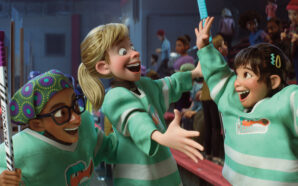Arturo Hilario
El Observador
“Turning Red” is the newest project from Pixar Animation Studios, and it tells the story of a spunky girl named Mei Lee, a 13-year-old Chinese-Canadian in the early 2000’s discovering her place in the world, while juggling the duty of family and her interests, which include hangouts with her friends and trying to manage the extreme adoration she has for the teen heartthrobs of her favorite boy band, 4*Town.
To add onto the chaos of adolescence, Mei has suddenly been afflicted with a condition that turns her into a giant red panda when her emotions get the best of her, which as it goes for most teens, tends to happen a lot.
We recently had the opportunity to speak to production designer Rona Liu, who first worked with director and co-writer Domee Shi on the Academy Award winning short “Bao”, on what her experience was like to be back collaborating with the director and how they looked back at their own adolescence and fashion choices to collaborate on bringing this story to life in the most authentic ways possible.
For my first question, I was really curious to know what it was like working alongside director Domee Shi after your collaboration on “Bao”, and how that transition was going from the animated short to a full feature length film?
Working with Domee, I would say the relationship that Miriam and Mei have in the film, she’s my ride or die, I love Domee. I would follow her off the edge of a cliff. She’s the most decisive director and the most edgy and fun and emotional director I have ever seen. I love her vision, I love her working style and transitioning from “Bao” to the feature film, I’m just really grateful that on “Bao” we had nine months to really develop our friendship and develop our working relationship.
And so coming into the feature film, we just have such a shorthand and such a kind of built-in trust that allowed her to focus on story and on making this wonderful, great film and directing all of the different departments. And it gave me freedom to work a little more behind the scenes and just collaborating with all the crew.
So the biggest difference, I would say, is on “Bao” things were just much more smaller scale. And by the time that production has started, the story was locked, story boards were locked, and we just had to make the short film. And on “Turning Red”, the story is changing as design is still moving. So everything was kind of like moving together and a lot of that took organization, but so much trust, which was so helpful again that we had worked together before.
Now, personally, why did you feel an attraction to the story in “Turning Red”?
Definitely Domee is the main reason for such a huge attraction because I just know that anything she does is going to be extremely relatable. It’s going to be extremely fun. And so whenever I hear that Domee is working on something, I’m just like, “I’m in. You don’t even need to pitch it to me. I will do anything with you, for you.”
But then when I actually heard the pitch, I was like, “Oh my goodness, I’m Mei!” I feel like everyone’s Mei, there’s a part of me that really relates to Mei. There’s a big part of me that relates to me because as I grow older, I can see I can understand the choices that my mom made, and I can because I am more of an adult, I can understand both sides.
And I was the confident dork, and I wasn’t perfect, even though I was trying to be an A plus student and I had acne, I had emotions, I had a wide, diverse friend range like Mei. So all of that is super relatable, everything from culture to aesthetic and interests. There was just so much that Domee loved that I can see myself loving, too.
Can you talk about what the process was of conceiving the aesthetics, and the overall visual style for the film?
Yeah, so conceiving the style and look of the film, I think Domee was very much like, “Hey, let’s look at our yearbooks. Let’s look at our old photos. Like, who were we when we were thirteen, and how did we dress like?”
So, for example, when we talk about the pastel colors, it’s really the things that we kind of remember us liking when we were 13. So it’s like I came home, and I would turn on the TV and watch, like, “Sailor Moon”, and I just loved how dreamy that anime was. So we really wanted to take those things that were such a huge part of our memory and put it into this film.
And, you know, from Mei’s Outfit, it’s literally the way we used to dress. Like Domee was like, “You know, I used to wear a denim miniskirt with leggings,” and I wore the sneakers. And then we had the preppy cardigan because sometimes we were exploring our different styles, and so it’s kind of like everything that we did meshed into a film.
And jumping off of that, how did you work with the rest of the team on keeping the story fully grounded in that authenticity?
I’m going to touch on kind of being sent home from the pandemic. It was really hard because we weren’t really used to this process, but so many of us have worked together before, and so we have a huge amount of respect and trust for each other. And so we have this bond, and with a lot of the supervisors, we had a friendship and a shorthand.
So part of keeping that consistent story and style throughout the whole entire production was just relying on each other, trusting each other, and having really great communication with each other. And in the beginning, Domee and I, we solidified a style guide with the pastel colors, with the chunky and cute style that we relay to the rest of the team and help people on board as they came onto the show.
It was very successful, and everybody was really excited about this style and really bought into it. And so I feel like all of that, the style guide, the communication, the trust, is what really helped us keep it cohesive.
And my last question, overall, what do you take away from the experience and what do you hope viewers take away from “Turning Red”?
Oh, my gosh. I really do hope that this story is about embracing yourself. It’s embracing different sides of yourself and it’s encouraging people, not just young kids, not just adults, but everybody to [realize], you don’t have to pick one side of you, you can have multifaceted sides of you and all of it is lovable.
And so I feel like number one, it’s about embracing who you are and believing in who you are and loving who you are. And two, we always said within our teams that if people watch this film and they go home and they call their moms and they tell them that they love them, then we really feel like we did our job because this is really about loving your family too, and keeping that connection despite all of the changes you go through.
“Turning Red” premieres exclusively on Disney+ March 11, 2022.






